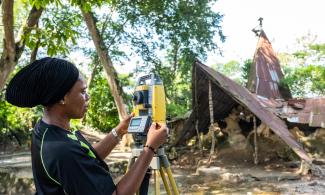
The 3D documentation of the Busanyin Shrine provides the most accurate record of the current conditions of the site to effectively plan a restoration project.
The United States’ Mission to Nigeria on Thursday celebrated the 3D documentation of the Busanyin Shrine at Osun-Osogbo Sacred Grove.
The 3D documentation of Busanyin which is one of the eight monuments within the Osun-Osogbo Grove was completed with the support of the U.S. Ambassadors Fund for Cultural Preservation (AFCP).
The project titled, “Digital Documentation, Training and Conservation Planning for National Heritage Busanyin Shrine within the Osun-Osogbo Sacred Grove” was awarded to CyArk, a California-based nonprofit organisation.
The US Consul General, Will Stevens, while speaking at the public presentation of the project in Osogbo, Osun State capital explained that the 3D documentation of the Busanyin Shrine provides the most accurate record of the current conditions of the site to effectively plan a restoration project.
Stevens extolled CyArk, Adunni Olorisa Trust and their local partners for working so hard to preserve a valuable national heritage in the state.
He further commended their efforts in providing training to local professionals to build capacity in digital documentation skills and cultural heritage management.
Stevens said that “The United States Mission to Nigeria has a long history of supporting the protection and preservation of Nigerian cultural heritage through the Ambassador’s Fund for Cultural Preservation.”
He added that “We have funded over $ 1 million for preservation projects across Nigeria through the AFCP in the last 10 years.”
In addition to the Busanyin Shrine project, additional AFCP projects include documentation and conservation of the 14th-century Sungbo Eredo earthworks of the Yoruba Ijebu Kingdom in southwest Nigeria; documentation of the Ifa oral traditions in Oyo State; rock art preservation project in Cross River and Jigawa states, among many others.
The US Mission also explained that the AFCP program was established in 2001 by the U.S. Congress to assist countries in cultural heritage preservation while also demonstrating American respect for other cultures.
The U.S. Mission to Nigeria reiterated that it will continue to explore opportunities to support the preservation of Nigeria’s rich cultural heritage using the AFCP and other partnership mechanisms.
The public presentation was attended by Nigerian alumni of U.S. government exchange programs, senior government officials, media leaders, representatives of cultural institutions, as well as officials of the National Commission for Museums and Monuments.